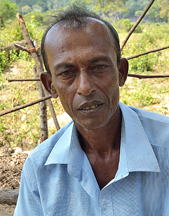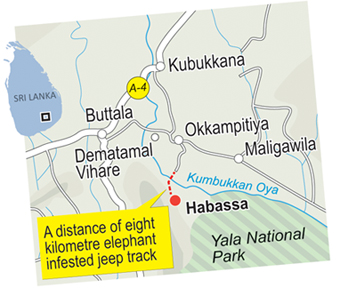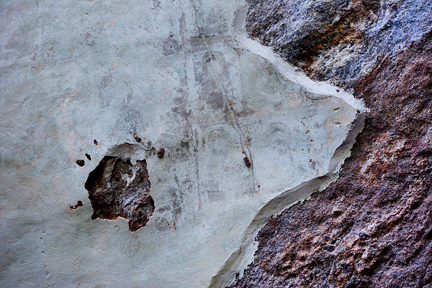Hidden treasures of Habassa
Story and pictures by Mahil Wijesinghe
|

The vandalised 25 feet long recumbent Statue of Buddha |
The word 'Habassa' evokes a sense of mystery and anticipation. Maybe
it is because we don't hear much about this archaeological site, located
in the vicinity of Okkampitiya, at the edge of Yala Block-IV, bordering
Kumbukkan Oya and home to Chena cultivations and gem mining.
Wild elephants are something you have to contend with when visiting
Habassa. With the endless forest as a backdrop, access is via a road
rarely travelled by either pilgrim or tourist. The Habassa
archaeological site is some eight kilometres from Okkampitiya. We are
accompanied by three villagers from Okkampitiya who are familiar with
the area.
They are Dammika Samarakoon, a provincial correspondent of Lake House
publications, R.M. Sudu Banda, caretaker of the Habassa archaeological
site and K.P. Piyadasa, elderly farmer living in Okkampitiya who knows
the movements of wild elephants.
We made our way slowly across the Kubukkan Oya, eyes and ears peeled
for any sight or sound of wild elephants. Peacocks constantly voiced
their irritation at the approaching vehicle, while the hawk eagle took
quick flight.
Overgrown canopy
Sudu Banda takes us to see the recumbent Buddha statue Habassa was
famous for once upon a time. It is a quick walk under the overgrown
canopy and a half hour's brisk climb to the ruins. Following a narrow
winding footpath, we first catch a glimpse of a huge stone foundation,
overgrowth with ferns. It is about six feet in height with massive stone
slabs erected around it. It is a cave complex. Some sections of the wall
have been dug and the stone slabs removed by treasure hunters in search
of precious gems.
|

R.M. Sudu Banda, caretaker of
Habassa archaeological site |
 Venturing
further, we come across countless ruins, reminding that this was once a
place of great significance. The site is littered drip-ledged natural
caves with Brahmin inscriptions and half buried stone pillars. On the
summit of the boulder that is Habassa there are hints of a figure of a
dancer or perhaps Bahirawaya, moulded in some claylike substance. Venturing
further, we come across countless ruins, reminding that this was once a
place of great significance. The site is littered drip-ledged natural
caves with Brahmin inscriptions and half buried stone pillars. On the
summit of the boulder that is Habassa there are hints of a figure of a
dancer or perhaps Bahirawaya, moulded in some claylike substance.
Cave complex
We walk past this and come face to face with the main Habassa cave
complex. Here, we find several upright stone pillars believed to have
been a roof in the past. Inside this long cave is the recumbent Buddha,
25 feet long and heart wrenchingly desecrated by treasure hunters. The
head lay smashed to bits, the stomach almost dug out and feet nowhere to
be seen. The statue is made of bricks and covered with a few layers of
lime plaster, all extensively damaged.
The remains of white lime plastered statue indicate the recumbent
statue probably dates back to the 9th Century AD and done in the
traditions of the Anuradhapura era. On the rock ceiling above the statue
are faded patches of paintings, with the outline faded in many places,
and blank spaces at others. The remnants of the paintings depict the
figure of Buddha attaining Enlightenment and traces of a Bo tree over
his head. Surrounding him are smaller panels with Buddha figures. The
remaining paintings indicate that the whole rock ceiling had been
covered with murals.
We next visit what appears to be the remains of a crumbling Chaitya -
a mound of earth and broken bricks overgrown with scrub - located just
five metres beneath the main rock cave. The site has also been
vandalised by treasure hunters.
Vandalism
The Habassa archaeological site encompassing 55 acres of land, lies
in a pathetic state today, not so much due to neglect as due to
vandalism and sheer ignorance of the villagers who live off the jungle.
Habassa and the adjoining Kubukkan Oya, which are famous gem areas have
become the target of organised groups of treasure hunters and illicit
gem miners from nearby villages, who have caused grave destruction to
the Habassa ancient site.
Sudu Banda says the destruction of the recumbent Buddha statue of
Habassa had taken place after 1989, and that many villagers who lived
close by kept away from the site due to armed gangs and LTTE presence in
the area.
|

The destroyed stupa, overgrown with ferns |

Remnants of murals on the rock ceiling over the statue |
|

